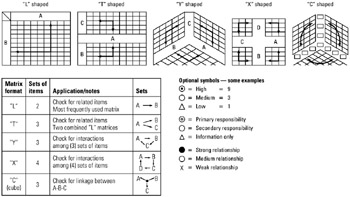Tool 106: Matrix Diagram
| AKA | Matrix Chart |
| Classification | Planning/Presenting (PP) |
Tool description
A matrix diagram is a planning tool that displays two or more sets of characteristics, functions, ideas, or issues. The scanning and comparing of items results in relationship "connections" or cause and effect interactions that can be useful in problem, opportunity, or task requirement analysis.
Typical application
-
To assign responsibility for action ideas.
-
To identify opportunities for improvement.
-
To search for possible problem causes.
-
To compare the respective strengths of alternative choices.
-
To match functions with resource needs.
Problem-solving phase
| Select and define problem or opportunity | |
| → | Identify and analyze causes or potential change |
| Develop and plan possible solutions or change | |
| → | Implement and evaluate solution or change |
| Measure and report solution or change results | |
| Recognize and reward team efforts |
Typically used by
| 6 | Research/statistics |
| Creativity/innovation | |
| 1 | Engineering |
| Project management | |
| 2 | Manufacturing |
| Marketing/sales | |
| 5 | Administration/documentation |
| 4 | Servicing/support |
| 3 | Customer/quality metrics |
| Change management |
before
-
Affinity Diagram
-
Tree Diagram
-
Interrelationship Digraph (I.D.)
-
Work Breakdown Structure (WBS)
-
Process Flowchart
after
-
Matrix Data Analysis
-
Activity Network Diagram
-
Process Decision Program Chart
-
Attribute Listing
-
Customer Acquisition-Defection Matrix
Notes and key points

Step-by-step procedure
-
STEP 1 Collect two or more sets of items from a brainstorming list, tree diagram, affinity diagram, or other source.
-
STEP 2 Select a particular matrix format. See example Improvement Tools Application by Function.
-
STEP 3 Construct a matrix diagram and insert sets or items.
-
STEP 4 Select a set of symbols to show relationship or connection.
-
STEP 5 Identify relationships, agree on the strength (use the appropriate symbol) of the relationship, and place the symbol at the intersecting points on the matrix.
-
STEP 6 Verify that all items have been changed and date the matrix diagram.
Example of tool application

EAN: 2147483647
Pages: 326